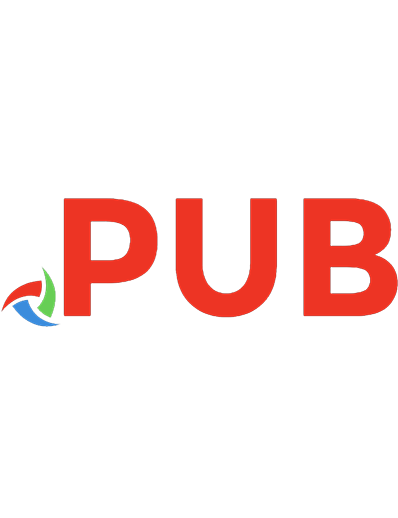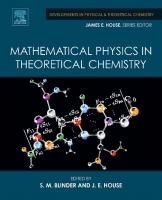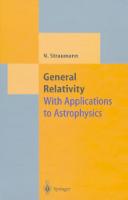Quantum Mechanics: Foundations and Applications: Texts and Monographs in Physics (Theoretical and Mathematical Physics) [3rd rev. and enlarged ed. 1993. Corr. 2nd printing] 0387979441, 9780387979441
This edition differs from the second chiefly in the addition of about tOO pages devoted to the quantum (or geometric, or
187 30 4MB
English Pages 688 [704] Year 1994
Table of contents :
Title Page
Copyright Page
Preface to the Third Edition
Preface to the Second Edition
Acknowledgments
Contents
I Mathematical Preliminaries
I.1 The Mathematical Language of Quantum Mechanics
I.2 Linear Spaces, Scalar Product
I.3 Linear Operators
I.4 Basis Systems and Eigenvector Decomposition
I.5 Realizations of Operators and of Linear Spaces
I.6 Hermite Polynomials as an Example of Orthonormal Basis Functions
Appendix to Section I.6
I.7 Continuous Functionals
I.8 How the Mathematical Quantities Will Be Used
Problems
II Foundations of Quantum MechanicsThe Harmonic Oscillator
II.1 Introduction
II.2 The First Postulate of Quantum Mechanics
II.3 Algebra of the Harmonic Oscillator
II.4 The Relation Between Experimental Data and Quantum-Mechanical Observables
II.5 The Basic Assumptions Applied to the Harmonic Oscillator, and Some Historical Remarks
II.6 Some General Consequences of the Basic Assumptions of Quantum Mechanics
II.7 Eigenvectors of Position and Momentum Operators; the Wave Functions of the Harmonic Oscillator
II.8 Postulates II and III for Observables with Continuous Spectra
II.9 Position and Momentum MeasurementsParticles and Waves
Problems
III Energy Spectra of Some Molecules
III.1 Transitions Between Energy Levels of Vibrating MoleculesThe Limitations of the Oscillator Model
III.2 The Rigid Rotator
III.3 The Algebra of Angular Momentum
III.4 Rotation Spectra
III.5 Combination of Quantum Physical SystemsThe Vibrating Rotator
Problems
IV Complete Systems of Commuting Observables
V Addition of Angular MomentaThe WignerEckart Theorem
V.1 IntroductionThe Elementary Rotator
V.2 Combination of Elementary Rotators
V.3 Tensor Operators and the WignerEckart Theorem
Appendix to Section V.3Representations of the Enveloping Algebras SO(3,1), SO(4), and E.
V.4 Parity
Problem
VI Hydrogen AtomThe Quantum-Mechanical Kepler Problem
VI.1 Introduction
VI.2 Classical Kepler Problem
VI.3 Quantum-Mechanical Kepler Problem
VI.4 Properties of the Algebra of Angular Momentum and the Lenz Vector
VI.5 The Hydrogen Spectrum
Problem
VII Alkali Atoms and the Schrdinger Equation of One-Electron Atoms
VII.1 The Alkali Hamiltonian and Perturbation Theory
VII.2 Calculation of the Matrix Elements of the Operator Q^-.
VII.3 Wave Functions and Schrdinger Equation of the Hydrogen Atom and the Alkali Atoms
Problem
VIII Perturbation Theory
VIII.I Perturbation of the Discrete Spectrum
VIII.2 Perturbation of the Continuous SpectrumThe Lippmann-Schwinger Equation
Problems
IX Electron Spin
IX.1 Introduction
IX.2 The Fine StructureQualitative Considerations
IX.3 Fine-Structure Interaction
IX.3a The Magnetic Moment of a Spinning Particle in Classical Physics
IX.3b The Spin-Orbit Interaction Term
IX.3c The Kinematical Correction Term
IX.4 Fine Structure of Atomic Spectra
IX.5 Selection Rules
IX.6 Remarks on the State of an Electron in Atoms
Problems
X Indistinguishable Particles
X.1 Introduction
Problem
XI Two-Electron SystemsThe Helium Atom
XI.1 The Two Antisymmetric Subspaces of the Helium Atom
XI.2 Discrete Energy Levels of Helium
XI.3 Selection Rules and Singlet-Triplet Mixing for the Helium Atom
XI.4 Doubly Excited States of Helium
Problems
XII Time Evolution
XII.1 Time Evolution
XII.A Mathematical Appendix: Definitions and Properties of Operators that Depend upon a Parameter
Problems
XIII Some fundamental Properties of Quantum Mechanics
XIII.1 Change of the State by the Dynamical Law and by the Measuring ProcessThe Stern-Gerlach Experiment
Appendix to Section XIII.1
XIII.2 Spin Correlations in a Singlet State
XIII.3 Bell's Inequalities, Hidden Variables, and the Einstein-Podolsky-Rosen Paradox
Historical Remark
Problems
XIV Transitions in Quantum Physical SystemsCross Section
XIV.1 Introduction
XIV.2 Transition Probabilities and Transition Rates
XIV.3 Cross Sections
XIV.4 The Relation of Cross Sections to the Fundamental Physical Observables
XIV.5 Derivation of Cross-Section Formulas for the Scattering of a Beam off a Fixed Target
Problems
XV Formal Scattering Theory and Other Theoretical Considerations
XV.1 The Lippmann-Schwinger Equation
XV.2 In-States and Out-States
XV.3 The S-Operator and the Mller Wave Operators
XV.A Appendix
XVI Elastic and Inelastic Scattering for Spherically Symmetric Interactions
XVI.1 Partial-Wave Expansion
XVI.2 Unitarity and Phase Shifts
XVI.3 Argand Diagrams
Problems
XVII Free and Exact Radial Wave Functions
XVII.I Introduction
XVII.2 The Radial Wave Equation
XVII.3 The Free Radial Wave Function
XVII.4 The Exact Radial Wave Function
XVII.5 Poles and Bound States
XVII.6 Survey of Some General Properties of Scattering Amplitudes and Phase Shifts
XVII.A Mathematical Appendix on Analytic Functions
a. Definition of Analyticity
b. Cauchy Integral Formula
c. Taylor Series
d. Laurent Series
e. Singularities
f. Cauchy Residue Theorem
g. Analytic Continuation
h. Schwarz Reflection Principle
i. Multivalued Functions
j. Riemann Surfaces
Problems
XVIII Resonance Phenomena
XVIII.1 Introduction
XVIII.2 Time Delay and Phase Shifts
XVIII.3 Causality Conditions
XVIII.4 Causality and Analyticity
XVIII.5 Brief Description of the Analyticity Properties of the S-Matrix
XVIII.6 Resonance ScatteringBreit-Wigner Formula for Elastic Scattering
XVIII.7 The Physical Effect of a Virtual State
XVIII.8 Argand Diagrams for Elastic Resonances and Phase-Shift Analysis
XVIII.9 Comparison with the Observed Cross Section: The Effect of Background and Finite Energy Resolution
Problems
XIX Time Reversal
XIX.I Space-Inversion Invariance and the Properties of the S-Matrix
XIX.2 Time Reversal
Appendix to Section XIX.2
XIX.3 Time-Reversal Invariance and the Properties of the S-Matrix
Problems
XX Resonances in Multichannel Systems
XX.l Introduction
XX.2 Single and Double Resonances
XX.2a Single Multichannel Resonance
XX.2b Double Multichannel Resonance
XX.3 Argand Diagrams for Inelastic Resonances
XXI The Decay of Unstable Physical Systems
XXI.1 Introduction
XXI.2 Lifetime and Decay Rate
XXI.3 The Description of a Decaying State and the Exponential Decay Law
XXI.4 Gamow Vectors and Their Association to the Resonance Poles of the S-Matrix
XXI.5 The Golden Rule
XXI.6 Partial Decay Rates
Problems
XXII Quantal Phase Factors and Their Consequences
XXII.1 Introduction
XXII.2 A Quantum Physical System in a Slowly Changing Environment
XXII.2.a Time Evolution for Parameter-Dependent Hamiltonians
XXIl.2.b Dynamical Phase and Geometrical Phase
XXII.3 A Spinning Quantum System in a Slowly Changing External Magnetic FieldThe Adiabatic Approximation
XXII.3.a Parameterization of the Eigenvectors
XXIl.3.b Berry Connection and Berry PhaseMagnetic Monopole Potentials
XXII.4 A Spinning Quantum System in a Precessing External Magnetic FieldThe General Cyclic Evolution
XXII.4.a The Exact State Vector
XXII.4.b The Dynamical and the Geometrical Phase Factor
XXII.4.c General Cyclic Quantum Evolution
Problems
XXIII A Quantum Physical System in a Quantum EnvironmentThe Gauge Theory of Molecular Physics
XXIII.1 Introduction
XXIII.2 The Hamiltonian of the Diatomic Molecule
XXIII.3 The Born-Oppenheimer Method
XXIII.4 Gauge Theories
XXIII.5 The Gauge Theory of Molecular Physics
XXIII.6 The Electronic States of Diatomic Molecules
XXIII.7 The Monopole of the Diatomic Molecule
Problems
Epilogue
Bibliography
1 Foundations of Quantum Mechanics
2 Scattering Theory
3 Theory of Angular Momentum and Group Theory
4 Experimental Subjects
5 Mathematical Material
6 History of Quantum Mechanics
7 Quantum Mechanics, Textbooks and Atomic Physics
8 Prerequisites from Classical Physics
Index
![Quantum Mechanics: Foundations and Applications: Texts and Monographs in Physics (Theoretical and Mathematical Physics) [3rd rev. and enlarged ed. 1993. Corr. 2nd printing]
0387979441, 9780387979441](https://dokumen.pub/img/200x200/quantum-mechanics-foundations-and-applications-texts-and-monographs-in-physics-theoretical-and-mathematical-physics-3rd-rev-and-enlarged-ed-1993-corr-2nd-printing-0387979441-9780387979441.jpg)

![Coherent Quantum Physics: A Reinterpretation of the Tradition (Texts and Monographs in Theoretical Physics) [1 ed.]
3110667290, 9783110667295](https://dokumen.pub/img/200x200/coherent-quantum-physics-a-reinterpretation-of-the-tradition-texts-and-monographs-in-theoretical-physics-1nbsped-3110667290-9783110667295.jpg)







